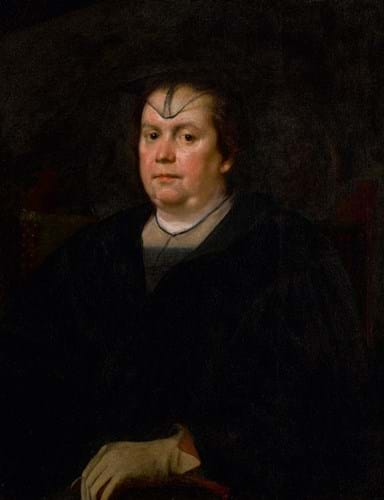
The subject is Olimpia Maidalchini Pamphilj – sister-in-law, reputed lover and puppet master of Pope Innocent X. Born into a noble family in Viterbo in 1591, she became one of the most influential figures at the papal court during her brother-in-law’s tenure and was nicknamed ‘Papessa’ – the ‘lady Pope’.
The Portrait of Olimpia Maidalchini Pamphilj has been authenticated by Sotheby’s following it being brought in to the auction house’s Amsterdam office 18 months ago.
James Macdonald, Sotheby’s senior specialist of Old Master paintings, said: “The search for Velázquez’s portrait of Donna Olimpia is finally over. Painted in Rome in 1650 by perhaps the greatest portrait painter of all time, this depiction of one of the most powerful and domineering woman of her time has long been recorded through early documents and engravings but was lost for nearly 300 years. Its recent rediscovery represents a highly significant addition to the great Spanish master’s oeuvre and the painting can be counted amongst only a handful of works by the artist remaining in private hands today.”

Diego Velázquez’s portrait of Olimpia Maidalchini Pamphilj - the most powerful and infamous woman in 17th century Rome. Dubbed the ‘Papessa’ and the ‘Mistress of the Vatican’, she was the power behind the throne of Pope Innocent X.
Painted in 1649-50 during Velázquez’s second trip to Rome, it will be offered at Sotheby’s London on July 3 at its Old Master sale and can be viewed from June 28.
Commissioned either by, or for Olimpia herself, the painting is documented as having been in the collections of numerous notable figures of 17th and 18th century Rome, including the sitter’s grandson Cardinal Camillo Massimi, a famous connoisseur and art patron, and Don Gaspar Mendez de Haro y Guzman, 7th Marques del Carpio, who by his death had amassed over 1800 paintings for his collection, including no fewer than six paintings by Velázquez. The painting was last recorded as being in the collection of Cardinal Pompeo Aldrovandi of Bologna and Rome in 1724, after which traces of the work are lost.
The auction house said it then disappeared from cataloguing and public knowledge and is believed to have appeared at auction in 1986 catalogued as ‘anonymous Dutch school’. Sotheby’s said an old custom stamp on the reverse of the former stretcher indicate that the painting had left Italy in 1911.





